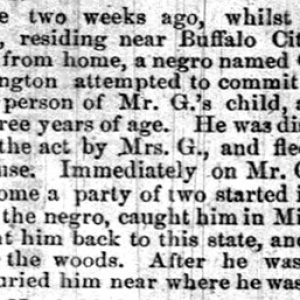calsfoundation@cals.org
George Washington (Lynching of)
In the spring of 1871, an African American named George Washington was lynched in Baxter County for allegedly assaulting a young girl. The girl’s father is variously referred to as James or George Calvin, with the surname sometimes given as Galvin. He lived on the White River south of Mountain Home (Baxter County).
Public records reveal nothing about these people. The 1870 census lists no adult George or James Calvin or Galvin in Baxter County, or even in the state of Arkansas. The same is true in neighboring counties in Missouri. There was also no African American named George Washington listed in Baxter County.
In his account of the lynching, Vincent Anderson quotes an article from the Baxter County Citizen, which was subsequently reprinted in the Ozark County Times on June 25, 1936. According to the Citizen, there were inaccurate and conflicting reports of the situation, and Dr. Jason Fritz Norman, who was “quite conversant with the circumstances and probably the only man living who saw the colored gentleman in aerial suspension,” decided to set the record straight. According to Norman, a young African American employed by Galvin on his farm assaulted Galvin’s infant daughter in mid-March 1871. The unnamed assailant, referred to only as “Black Tom,” then fled along the Old Salt Road past Mountain Home. Galvin tied a long rope to his saddle and pursued him.
Along the way, he met Jim Calhoun, who was employed by Andres Jackson (Jack) Coffey on Lick Creek in Ozark County, Missouri. Jim Calhoun was probably James Griffin Calhoun, who was living in Whiteville (Marion County) with his parents, Andrew Jackson Calhoun and Julia Calhoun, in 1860. Calhoun joined Galvin, and they eventually captured the alleged assailant. They took him back into Arkansas, and at “a knob just east of the old ‘Possum Walk Road…in the edge of Arkansas,” they hanged him from a tree, left him hanging, and departed. The body was not discovered, and eventually the bones fell to the ground. Dr. Norman, who was studying medicine at the time, subsequently took the skull. According to Norman, “no one seemed to censure Mr. Galvin for the course he took,” there was no publicity, and no one was ever arrested. Because of the lynching, the knob where the lynching occurred was subsequently called Nigger Knob.
Contrary to this account, there were some reports of the incident when it happened. On May 16, 1871, the Arkansas Gazette reprinted an article from the May 10 issue of the Batesville Republican. This report indicates that the incident had occurred two weeks earlier, which would have placed it in late April. According to this report, while James Calvin, who lived near Buffalo City (Baxter County), was away from home, a “negro named George Washington” tried to rape his three-year-old daughter. Calvin’s wife discovered him in the act, and he fled. Accompanied by another man, Calvin pursued Washington, captured him in Missouri, brought him back to Arkansas, and hanged him in the woods. This account indicates that Washington was buried near the site of the lynching. This same report was reprinted in the Nashville Union and American and the Wheeling Daily Intelligencer on May 18.
For additional information:
Anderson, Vincent S. “An 1871 Lynching in Baxter County, Arkansas.” Ozarks’ History. June 22, 2013. http://ozarkshistory.blogspot.com/2013/06/an-1871-lynching-in-baxter-county.html (accessed October 13, 2020).
“State News: Independence.” Arkansas Gazette, May 16, 1871, p. 1.
Nancy Snell Griffith
Davidson, North Carolina
 Civil Rights and Social Change
Civil Rights and Social Change Civil War through Reconstruction, 1861 through 1874
Civil War through Reconstruction, 1861 through 1874 Washington Lynching Article
Washington Lynching Article 




Comments
No comments on this entry yet.